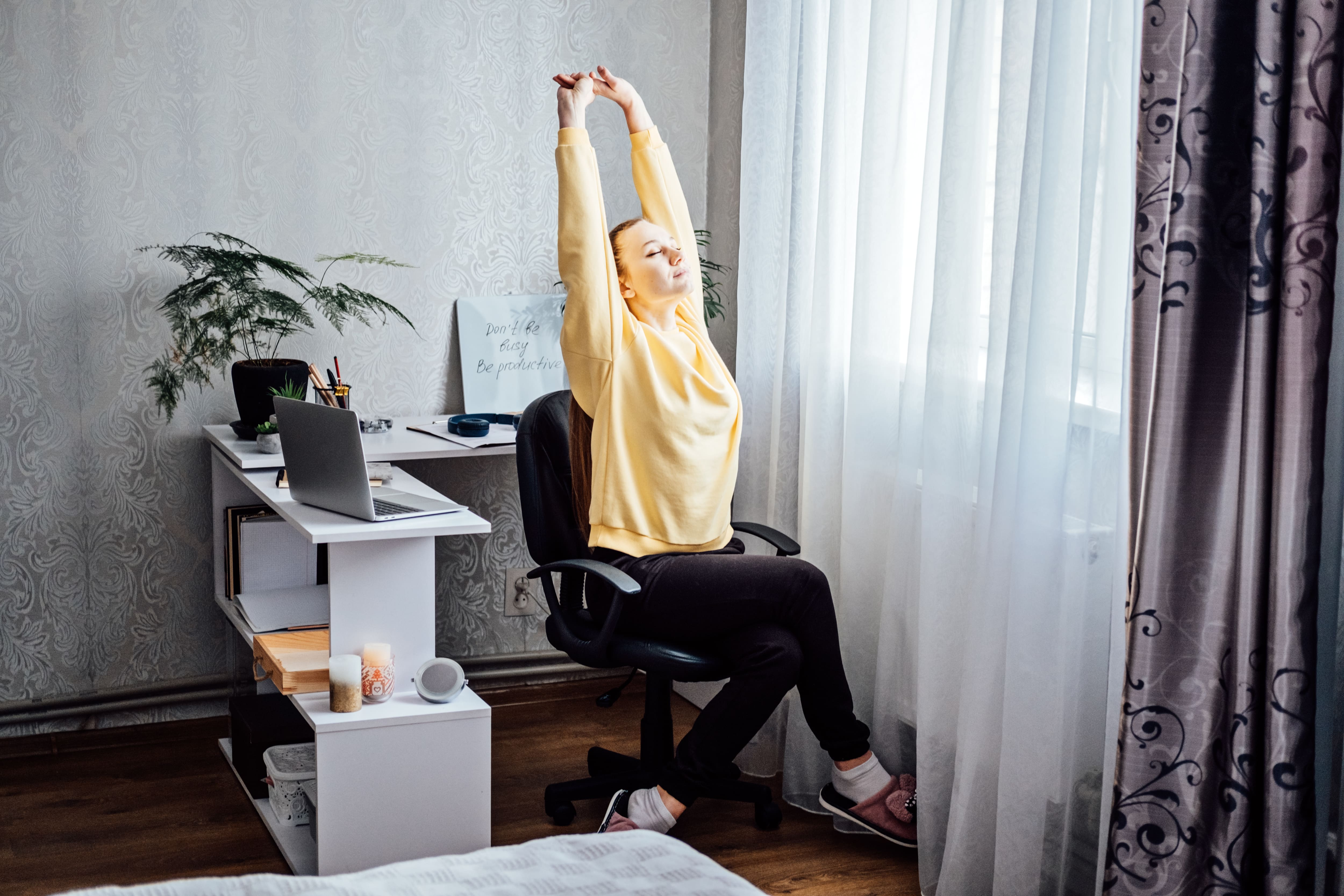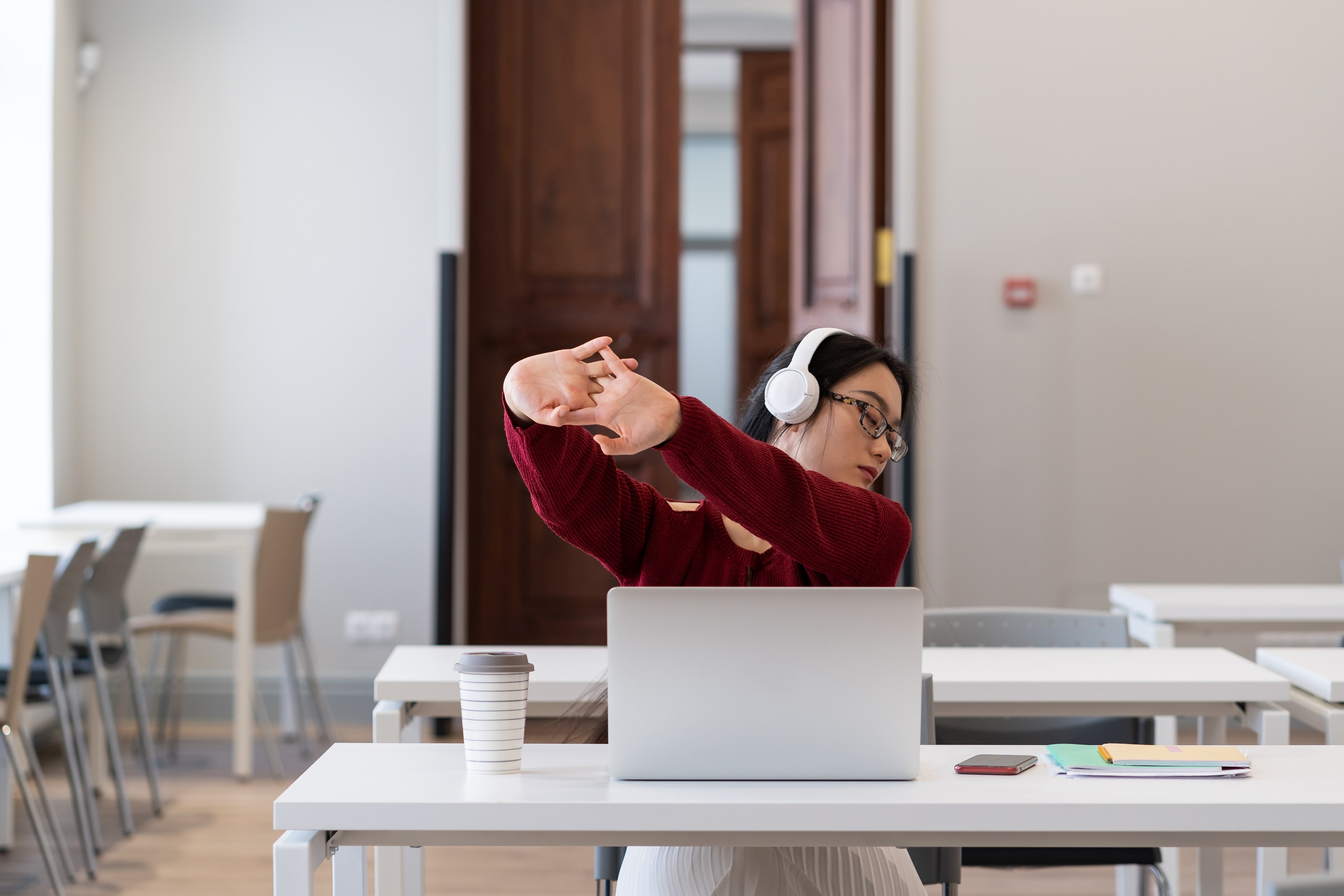Key Takeaways
- Incorporating short stretching breaks throughout a sedentary day is a simple yet powerful strategy to actively improve insulin sensitivity and manage blood sugar levels.
- Regular mobility exercises, particularly those targeting common problem areas such as the neck, shoulders, and lower back, are crucial for preventing chronic pain and injuries often linked to poor posture and muscle tightness resulting from prolonged sitting.
- Utilizing data from a glucose monitor (CGM) allows you to scientifically validate which movements are most effective for your body, turning passive breaks into actionable metabolic health interventions.
{{mid-cta}}
Let’s face it, our lives are dominated by sedentary behaviours, often in non-ergonomic setups that limit blood flow and strain the lower back and neck. These prolonged periods of limited physical activity can reduce the range of motion and lead to tight muscles across multiple muscle groups. The cumulative strain can manifest as muscle tension, poor circulation, and even fluctuations in blood glucose levels.1 Is there a simple solution? Well, actually yes: mobility exercises.
These gentle movements go beyond just stretching; they actively ease stiffness, promote healthy blood flow, and can play a significant role in helping to regulate blood sugar levels.2
Incorporating simple stretching exercises into your daily routine can dramatically improve physical health, well-being, and energy levels. This article explores the effects of stagnation on the body, how stretching can help mitigate these negative health impacts, and how you can incorporate a CGM into your stretching routine.
Why Sedentary Stagnation Triggers Metabolic Stress

Beyond metabolic shifts, a sedentary lifestyle contributes to muscle stiffness, poor posture, and reduced activation of the glutes and hip flexors, all of which can cause chronic pain in the back and joints. Being overly sedentary also impacts the body's metabolic health by reducing insulin sensitivity in muscle cells. When muscles are inactive or when our body loses muscle mass, they become less efficient at taking up glucose from the bloodstream. This leads to a sustained increase in blood sugar levels, a condition known as hyperglycemia. To counteract this, the pancreas releases more insulin.
Over time, cells become "resistant" to insulin’s effects, a.k.a insulin resistance. A vicious cycle commences where higher and higher levels of insulin are needed to manage blood sugar, which can eventually exhaust the pancreas and lead to metabolic stress and conditions like type 2 diabetes. It also heightens musculoskeletal strain from prolonged sitting and can negatively impact mental health and overall wellness.
Combining this with stagnation reduces the activity of key metabolic enzymes, impairs the body's ability to process fats and carbohydrates, and further worsens metabolic health and chronic inflammation. Movement really is a powerful medicine.
Stretching as a Metabolic Reset: The Underappreciated Power Move

Brief bouts of mobility exercises can significantly counteract the negative metabolic and musculoskeletal effects of prolonged sitting or standing. Incorporating a balanced stretching routine that includes both dynamic stretching and static stretching can help counteract the effects of sedentary behavior.
A 2022 randomized clinical trial found that just 8 weeks of static stretching, performed for 30 minutes 2-3 times per week, led to significantly improved blood sugar levels in patients with type 2 diabetes.3 Another study found stretching protocols to cause immediate lowering of blood glucose levels in participants with and without type 2 diabetes, with results being more significant in those with diabetes.4 Authors believe these results are due to an increase in activity of glucose transporter proteins, which improves sugar uptake by the muscle cells and long-term insulin sensitivity.
Stretching exercises are also found to be crucial for reducing chronic pain and stiffness. Targeting the upper back, shoulders, and lower body through shoulder stretches, hamstring stretches, and spinal twists supports posture and joint mobility. Studies have shown that dynamic stretching exercises, particularly for areas like the neck, shoulders, and lower back, can alleviate pain by improving joint range of motion and correcting postural imbalances.5
Even a few deep breaths before or after a session can calm the nervous system and support stress management. It is clear that engaging in consistent, regular movement breaks is a powerful tool in helping to manage blood sugar, weight, and prevent long-term injuries.
The Signos Method: Stretch with Insight, Not Just Relief

A glucose monitor (CGM) enables you to understand your body's unique response to exercise, empowering you to create an effective routine that turns short movement breaks into potent moments of glucose management. Here is an example of the various features used by Signos to help gather and interpret your data during mobility breaks:
- Glucose Insight Loop: This feature enables you to track how your glucose levels change before and after a stretch session, allowing you to fine-tune the movements for your ultimate mobility routine.
- Stress-to-Glucose Link: Stretching has been found to be an effective strategy in stress management.6 Signos data will help you see how reducing stress via stretching directly leads to more stable glucose trends over time.
- Perfusion Feedback: Signos will collect data to confirm whether the stretches are increasing blood flow to your muscles and how this improved circulation affects glucose stabilization and overall wellness. Regular feedback encourages healthier daily activities and helps you build a sustainable stretching routine that reduces stress levels and supports mental health.
Simple Desk Stretch Series That Supports Metabolism

These simple stretches are ideal desk stretches for anyone with a sedentary lifestyle or long workday. Here are 3-5 stretches you can perform at your desk to improve circulation, reset posture, and support your metabolic function:
- Seated Torso Twist: This gentle spinal twist helps increase range of motion in the upper body. Sit tall with your feet flat on the floor. Inhale and lengthen your spine. As you exhale, gently twist your torso to the right, placing your right hand on the back of your chair and your left hand on the outside of your right knee. Hold for 20-30 seconds, then release and repeat on the other side.
- Seated Hamstring Stretch: While seated, extend your right leg straight out in front of you with your heel on the floor and toes pointing up. Keep your back straight and hold for 20–30 seconds per leg to release tight muscles in the lower body.
- Neck and Shoulder Rolls: This sequence relieves shoulder pain, loosens shoulder muscles, and combats upper back tension from poor posture. Sit upright and relax your shoulders away from your ears. Slowly roll your shoulders forward in a circular motion, then reverse the motion and roll them backward. Next, gently drop your right ear toward your right shoulder, holding for 15-20 seconds. Repeat on the left side. Finally, slowly roll your head in a full circle, both clockwise and counter-clockwise.
- Ankle Pumps/Circles: While seated, lift your feet off the floor slightly. Point your toes away from you, then flex your feet back toward your shins. Then, slowly rotate your ankles in a circle 10 times in both directions.
- Seated Figure-4 Stretch: Sit tall and cross your right ankle over your left knee, creating a "figure-4" shape. Gently press down on your right knee with your hand until you feel a stretch in your outer hip, glutes, and hip flexor. Hold for 20-30 seconds, then repeat on the other side.
Daily Flow: Seamless Office Mobility + Metabolic Support

Try this simple daily routine that incorporates short movement breaks and suggestions on the best times to check your CGM. Use these movement breaks as mini warm-ups to keep blood flow consistent and prevent muscle stiffness.
- 9:00 AM: Note your starting glucose level on your CGM to establish a baseline for the morning. This is typically after you’ve already eaten breakfast.
- 9:30 AM and 10:30 AM: Perform 10 repetitions of the Seated Torso Twist and Neck Rolls to keep the spine moving, as well as a set of 15-20 repetitions of Ankle Pumps and a Seated Hamstring Stretch to bring blood flow into the lower body. You can add 10 shoulder rolls and 10 reps of seated lunges to further activate your lower body and improve range of motion.
- 11:30 AM: Before lunch, check your Signos data again and see if your morning movements have helped keep your glucose curve steady so far.
- 1:30 PM: After lunch, perform one set of the Seated Hamstring Stretch and Figure-4 Stretch (20-30 seconds per side) as well as 10 repetitions each of Neck Rolls, Shoulder rolls, and the Seated Torso Twist.
- 2:30 PM: Perform another set of 10 Neck and Shoulder Rolls and a few deep belly breaths to check in on your posture.
- 4:00 PM: Take a final look at your Signos data. Notice if your afternoon movements have contributed to a more stable trend for the latter half of the day. A brief back stretch or neck stretch at this point can help maintain posture and reduce fatigue.
The Bottom Line
Sometimes the simplest stretching exercises yield the greatest benefits of stretching, from improving blood flow and mobility to lowering cortisol and stabilizing glucose. These brief movement breaks can reduce stress hormone levels, combat obesity risk linked to sedentary behavior, and support long-term weight loss and well-being. With Signos’s real-time assistance, you can tailor your mobility routine to support your body and your metabolic health, one stretch at a time.
Learn More About Signos’ Expert Advice
If you have more questions on improving your health, fitness, and nutrition, seek the expert advice of the Signos continuous glucose monitor and the Signos team. A continuous glucose monitor (CGM) can give you the insights to make smarter nutrition and exercise choices. The Signos app offers a personalized program to help you achieve your health goals.
Topics discussed in this article:
References
- Damayanti, L. S. (2025). The impact of sedentary behavior on blood glucose levels in type 2 diabetes mellitus patients: A literature review. Journal of Evidence-based Nursing and Public Health, 2(1), 34-52.
- León, D. G., Gittermann, L. M. T., Isla, N. S., Boratovic, S. R. V., & von Oetinger Giacoman, A. (2022). Effects of break in sedentary behaviour on blood glucose control in diabetic patients. Systematic review. Endocrinología, Diabetes y Nutrición (English ed.), 69(10), 888-896.
- Shirodkar, S., Deo, M., Agnihotri, M., & Epte, R. (2022). Effect of Static Stretching on Random Blood Sugar Levels in Type 2 Diabetes Mellitus: A Randomized Clinical Trial. IJHSR, 12(7), 156-62.
- Thomas, E., Ficarra, S., Nakamura, M., Drid, P., Trivic, T., & Bianco, A. (2024). The effects of stretching exercise on levels of blood glucose: a systematic review with Meta-analysis. Sports medicine-open, 10(1), 15.
- Plandowska, M., Labecka, M. K., Truszczyńska-Baszak, A., Rajabi, R., & Płaszewski, M. (2024). A Randomized Controlled Trial of Active Stretching of the Hamstrings and Core Control for Low Back Pain and Musculoskeletal Discomfort during Prolonged Sitting among Young People. Journal of clinical medicine, 13(17), 5048.
- Corey, S. M., Epel, E., Schembri, M., Pawlowsky, S. B., Cole, R. J., Araneta, M. R. G., ... & Kanaya, A. M. (2014). Effect of restorative yoga vs. stretching on diurnal cortisol dynamics and psychosocial outcomes in individuals with the metabolic syndrome: The PRYSMS randomized controlled trial. Psychoneuroendocrinology, 49, 260-271.


.jpg)

.svg)










.svg)
.svg)
.svg)
.svg)
.svg)
.svg)
.svg)
